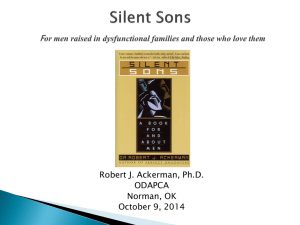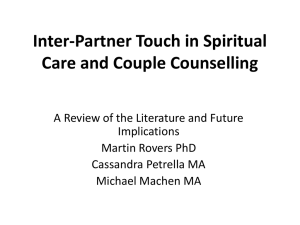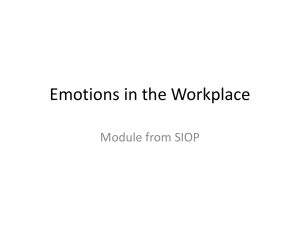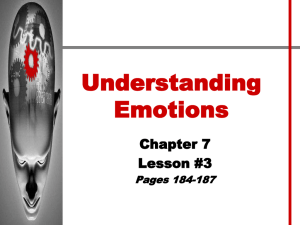Emotionally Focused Therapy
advertisement
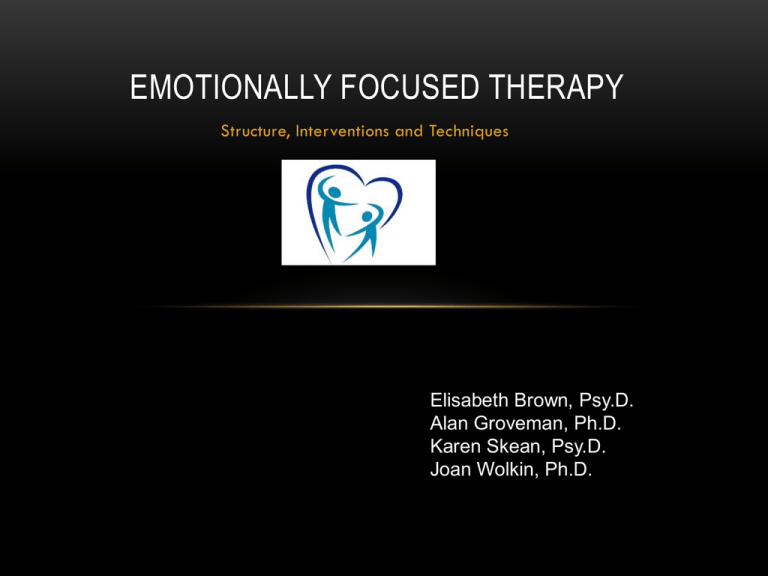
EMOTIONALLY FOCUSED THERAPY Structure, Interventions and Techniques Elisabeth Brown, Psy.D. Alan Groveman, Ph.D. Karen Skean, Psy.D. Joan Wolkin, Ph.D. EMOTIONALLY FOCUSED THERAPY EMOTIONALLY FOCUSED THERAPY: PRIMARY ROOTS OF EFT Learning Objective •Describe the theoretical underpinnings of Emotionally Focused Therapy •Be familiar with the three stages and nine steps framework of EFT •Understand the concepts of enactments, withdraw engagement and blamer softening •Be conversant with the research supporting EFT K EMOTIONALLY FOCUSED THERAPY: OVERVIEW AND THEORETICAL ASSUMPTIONS PRIMARY ROOTS OF EFT • Experiential Therapy (Perls) • Person Centered Therapy (Rogers) • Systemic Therapy (Minuchin) • Attachment Theory (Bowlby) K BASIC OVERVIEW OF EFT The primary goals of EFT are to: • Access, expand and re-organize key emotional responses between partners. • Create a shift in each partner’s interactional positions in their rigid interactions with one another. • Foster the creation of a secure bond between partners through the creation of new interactional experiences that redefine the relationship. K What Makes EFT, EFT – Its Look and Feel 1. Relentless Empathy 2. Attachment Frame and Language 3. De-pathologizing Model 4. RISSSC 5. Enactments E SKILLS FOR EMOTIONAL ENGAGEMENT R-I-S-S-S-C R: The therapist intentionally REPEATS key words and phrases for emphasis. I: Therapist uses IMAGES or word pictures that evoke emotions more than abstract labels tend to do. S: Therapist frames responses to clients in SIMPLE and concise phrases. S: Therapist will SLOW the process of the session and the pace of her speech to enable deepening of emotional experience S: Therapist will use SOFT and soothing tone of voice to encourage a client to deepen experience. C: Therapist uses CLIENT words and phrases in a supportive/validating way. E ENACTMENTS Types of EFT Enactments 1. Diagnostic enactments 2. Highlighting rarely occurring positive interaction 3. Enacting present positions 4. Turning new emotional experience into new responses E ENACTMENTS A Model for Creating Effective Enactments 1. Setting the Stage 2. Directing One Partner to Make Contact with the Other 3. Processing Each Partner’s Experience of the Enactment E Role Play OVERVIEW OF EFT TREATMENT PROCESS • Develop an alliance, identify cycle, identify and access underlying emotions, and work to de-escalate • Help couple see the negative cycle as the enemy, not each other • Engage the withdrawer • Soften the pursuer/blamer • Create new emotional bonding events and new cycles of interaction • Consolidate new cycles of trust, connection and safety, and apply them to old problems that may still be relevant K ATTACHMENT • Withdrawer • “I never get it right or make her happy.” • “I don’t bother anymore what’s the point.” • (Feelings: Rejected, inadequate, fears failure, • overwhelmed, judged, shame, empty, alone) • Pursuer • “He’s never around and whenever he is he’s • always distracted.” • “She doesn’t see me. No matter what I do I don’t • count in her world.” • (Feelings: Hurt, unwanted, invisible, abandoned, • desperate, deprived, not important K COMMON UNDERLYING EMOTIONS OF WITHDRAWERS AND PURSUERS • Rejected • Hurt • Inadequate • Alone • Afraid of failure • Not wanted • Overwhelmed • Invisible • Numb – frozen • Isolated/disconnected • Afraid – scared • Not important • Not wanted or desired • Abandoned • Judged, critized • Desperate K EFT 3 STAGES AND 9 STEPS • Stage 1 Assessment and Cycle De-Escalation • Stage 2 Changing Interactional Positions and Creating New Bonds • Stage 3 Consolidation and Integratio n J THE NINE STEPS OF EMOTIONALLY FOCUSED COUPLES THERAPY Step 1-4 • Alliance and assessment: Creating an alliance and delineating conflict issues in the core attachment struggle. What are they fighting about and how are they related to core attachment issues? J STEP 1 - ESTABLISHING AN ALLIANCE • Reflection • Validation • Empathic Attunement J THE NINE STEPS OF EMOTIONALLY FOCUSED COUPLES THERAPY Step 2 Identify the negative interaction cycle EFT Cycle levels include • • • • • Action tendencies (behaviors) Perceptions Secondary Emotions Primary Emotions Unmet Attachment Needs The goal is for the therapist to see the cycle in action and identify and describe it to the couple and work toward stopping it. E IDENTIFYING & DELINEATING NEGATIVE INTERACTIVE CYCLE • Basic Negative Cycles & Interactive Positions • Pursue/Withdraw • Withdraw/Withdraw • Attack/Attack • Complex cycles • Reactive pursue/Withdraw E EFT EMOTIONS AND REACTIVITY Emotions occur at two levels: Primary and Secondary (or reactive). Primary Emotions are the deeper, more vulnerable and tender emotions such as sadness, hurt, fear, shame, and loneliness. Secondary Emotions are the more reactive emotions such as anger, jealousy, resentment, and frustration. They occur as a reaction to the primary emotions. Anger, Blame, Primary emotions generally draw partners closer. Secondary emotions tend to push partners away. E STEP 2 – IDENTIFYING THE NEGATIVE CYCLE • Who is the Pursuer? • Who is the Withdrawer? • Describe the Negative Cycle • What are the Secondary Emotions? • What are the Primary Emotions? Sue Negative Cycle Clip E THE NINE STEPS OF EMOTIONALLY FOCUSED COUPLES THERAPY Step 3 Access unacknowledged emotions underlying interactional positions. The goal is to help each member of the couple to access and accept their unacknowledged feelings that are influencing their behavior in the relationship. Both partners are to "reprocess and crystallize their own experience in the relationship" so that they can become emotionally open to the other person. J STEP 3 ACCESS UNACKNOWLEDGED EMOTIONS UNDERLYING INTERACTIONAL POSITIONS. J THE NINE STEPS OF EMOTIONALLY FOCUSED COUPLES THERAPY Step 4 Reframe the problem in terms of underlying feelings, attachment needs, and negative cycles. The cycle is framed as the common enemy and the source of the partners’ emotional deprivation and distress. J EFT REFRAMES STEP 4 For example: Angry Criticism is viewed in EFT as: • an attempt to modify the other partner’s inaccessibility or manage the disconnect • a protest response to emotional isolation and abandonment not being “crazy or irrational”. Avoidance is seen as: • an attempt to contain the interaction and regulate fears of rejection or not burden the other partner • an attempt to avoid confrontation or working models that define the self as unlovable . J STEP 4 J The Cycle Scott R. Woolley Ph.D. © Partner Behavior Perceptions/Attributions Secondary Emotion Partner Behavior Perceptions/Attributions Secondary Emotion -------------------------------------------------------------------------------------------------------------- Primary Emotion Unmet Attachment Needs Primary Emotion Unmet Attachment Needs E THE NINE STEPS OF EFT STAGE 2 STEPS 5-7 Step 5- Withdrawer Re-Engagement and Pursuer Softening Promote identification with disowned attachment emotions, needs and aspects of self, and integrate these into relationship interactions. Help the couple redefine their experiences in terms of their unacknowledged emotional needs. "I nag because I feel abandoned and I want to be loved." "I withdraw because I feel invaded and rejected and I need to feel safe and loved." A THE NINE STEPS OF EMOTIONALLY FOCUSED COUPLES THERAPY Step 6 Promote acceptance of the other partner’s experiences and new interactional responses . Work to get each partner to accept, believe, and trust that what the other partner is describing in terms of underlying emotional needs is accurate. A THE NINE STEPS OF EMOTIONALLY FOCUSED COUPLES THERAPY Step 7 Facilitate the expression of needs and wants and create emotional engagement and bonding events that redefine the attachment between the partners. Help them learn to express their emotional needs and wants directly rather than through the old patterns and create emotional engagement. This will help each person see the other person in a more benign manner. (Feeling vulnerable and insecure rather than rejecting.) A STEPS 5,6,7 Stage 3 – Consolidation • Step 8 – Facilitating the emergence of new solutions to old relationship patterns • Step 9 – Consolidating new positions and new cycle of safe attachment and connections A SOFTENING • Pre-requisites: • De-escalation of negative cycle (Stage 1) • Withdrawer re-engagement (Stage 2 change event) • A previously hostile, critical partner accesses “softer” emotions and risks reaching out to his/her partner who is engaged and responsive. • In this vulnerable state, the previously hostile partner asks for attachment needs to be met. A SOFTENING • At this point, both partners are attuned, engaged and responsive (accessibility & responsiveness) • A bonding event then occurs which redefines the relationship as a safe haven and a secure base. A CONTRAINDICATIONS OF EFT • Different Agendas • Separating Couples • Abusive Relationships • Substance Abuse • Depression and Other Psychiatric Illness A RESEARCH • 70 – 73% recovery rate in 10-12 sessions. • Results stable – even under high stress. • Depression significantly reduced. • Variety of populations and settings. • Best predictor of success – female faith in partner’s caring (Not initial distress level). K QUESTIONS ATTACHMENT • Attachment History - (View of Self and View of Other) • “When you were young (ages 6 – 10) who did you turn to for care and comfort in a time of need? Can you tell me what that was like?” • Secure: A person is better able to acknowledge and cope effectively with negative emotions. Adults are self-confident, socially skilled, interested in close, romantic relationships, an more likely to form stable and satisfying long-term relationships. Avoidant: A person often attempts to block out negative emotions, and are Uncomfortable seeking support. Adults lack self-confidence, are worried about rejection and abandonment. They are prone to bouts of jealousy and anger. They see partners as untrustworthy. Seek romantic relationships, but may choose ill-advised partners. • • • • Anxious: A person is highly emotionally expressive but often cannot regulate their emotions. Adults are uncomfortable with closeness, self-disclosure, dependence on others, and are more socially unskilled. K





